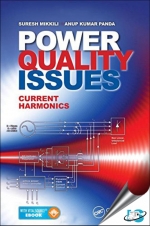Tab Article
Power Quality Issues: Current Harmonics provides solutions for the mitigation of power quality problems related to harmonics. Focusing on active power filters (APFs) due to their excellent harmonic and reactive power compensation in two-wire (single phase), three-wire (three-phase without neutral), and four-wire (three-phase with neutral) AC power networks with nonlinear loads, the text:
- Introduces the APF technology, describing various APF configurations and offering guidelines for the selection of APFs for specific application considerations
- Compares shunt active filter (SHAF) control strategies for extracting three-phase reference currents, evaluating their performance under a number of source voltage conditions using a proportional-integral (PI) controller
- Presents PI controller-based SHAF instantaneous active and reactive power (p-q) and instantaneous active and reactive current (Id-Iq) control strategies, supplying detailed MATLAB®/Simulink simulation results
- Proposes SHAF control strategies using type 1 and type 2 fuzzy logic controllers (FLCs) with different fuzzy membership functions (MFs), analyzing their harmonic mitigation and DC link voltage regulation
- Verifies the proposed type 2 FLC-based SHAF control strategies with trapezoidal, triangular, and Gaussian fuzzy MFs using RT-LAB, a real-time digital simulation software from OPAL-RT Technologies
Power Quality Issues: Current Harmonics is a useful resource for those tackling electrical power quality challenges. The compensation techniques described in this book alleviate harmonic issues that can distort voltage waveforms, fry a building’s wiring, trigger nuisance tripping, overheat transformer units, and cause random end-user equipment failure.


